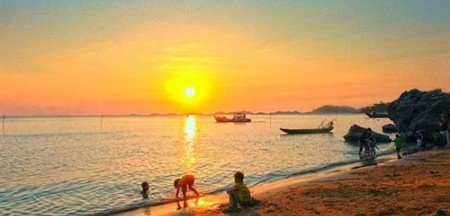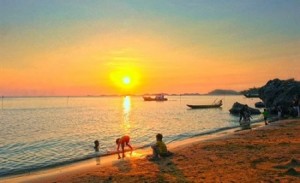If you’re looking for somewhere historically rich and naturally beautiful, Bung Binh Thien is an ideal place to visit. Located in the South Western region of Vietnam, it is most spectacular in the monsoon season, from July to October, when visitors can fully enjoy its magnificence.
The name itself suggests pure beauty. Bung means “lake,” Binh means “serene and peaceful,” and Thien means “sky.” It is made up a bigger and smaller area, the former 193 hectares big and the latter 10 hectares. The lake is about five metres deep, with the water coming from two other lakes, the Mekong River in Cambodia and the Tien abd Hau Rivers in Vietnam. Its reddish, seemingly opaque colour comes from the Binh Di River, but turns crystal blue clear once it merges with Bung Binh Thien Lake. Lotus, water lilies and water hyacinth decorate the whole scene, while algae perform important environmental functions of filtering the water, preventing torrents and maintaining the clear blue colour of the water.
Bung Binh Thien was discovered in the 18th century by a general of the Tay Son dynasty who chose the place to stock their food and train their soldiers. The ground was barren at that time, so the officer performed a ceremony praying to the earth gods for rain and water. According to local myth, the general then struck his sword into the ground wherein fresh water suddenly appeared, creating the lake that the place is known for today.
But Bung Binh Thien is not all about the lake. There are other interesting sights and people to see in the area which creates its uniquely beautiful character. There are four ethnic groups residing in the area, each with its one-of-a-kind identity: Kinh; Hoa; Khmer; and Cham. The latter in particular is a special kind of group who has a simple but solid set of traditions. They live in a 100-year old village with houses built close to each other, indicative of their close knit culture. The elderly frequent the temple to pray, while children play in the streets. The women are particularly identified for their stunning traditional costume.
The Mas Jid Khoy Ri Yah is a popular Islamic mosque which the Cham people visit often to worship. It is designed with South West architecture, characterized with its intricate style of arched roofs and domes, pointed tops, upside down U-shaped doors and big columns. The Cham people are usually farmers who work in the fields during the dry season, but in the water season, they double as chefs who serve one-of-a-kind dishes in equally unique diners which are made of stilt houses. Snake-head mullet noodles; banh khot (little savory pancakes); banh xeo (sizzling crepes with Egyptian river hemp filling); shrimp sauce hot pot with climbing perch; Egyptian river hemp; water lilies with dipping sauce; henicorhynchus fish patties; and stewed henicorhynchus fish with green tamarind are authentic Cham dishes which every visitor must try.
At night, the Cham people entertain their guests with a show on the lake on a floating stage which is generally rustic but more than makes up for with its naturally breathtaking view and performance of the locals.
For those who are looking for tranquillity and beauty, Bung Binh Thien is definitely a must-visit, not inly in the monsoon but generally the whole year round because the place is just simply, naturally magnificent.

